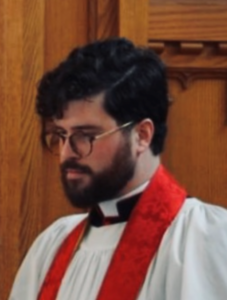
Canon Gagliano is a member of the Dio Board and clergy-person in the Diocese of Quebec. This fall, he wrote the text for the new College Anniversary Hymn. Scroll to the bottom of the page for the hymn text!
Tell me about the creative process. How did you begin to come up with the text for this hymn?
About a year ago, I was invited by the Principal to write a special hymn for Dio’s 150th anniversary. At the time I was wondering what I could possibly write. The Dio newsletter was sitting on my kitchen counter one evening, and I saw the school’s motto on the front cover (‘Pro Christo et Ecclesia’, meaning ‘for Christ and the Church’). The rest of the hymn flowed from that last line: “Pro Christo et ecclesia / shall be our endless song.” Whether they are formed now or in any of the college’s 150 years, each Dio student is called to serve Christ and the Church.
What kinds of themes and ideas inspired the text?
This text is essentially a Transfiguration hymn. I believe this event is a wonderful metaphor for the seminary experience. Christ calls a few of his disciples to follow him to a special place, they witness something holy, and then they re-enter the world to share what they beheld.
Why did you choose the tune of Thaxted?
It has the triple benefit of being well-known, beloved, and majestic (like “Pomp and Circumstance” with a bit more pathos). I first heard the tune when I was a teenager and have had it tucked in the back of my mind as a potential tune since I began to write hymns.
Were there particular biblical references you felt were important to weave in throughout the text given the occasion you were writing for?
Hymn-writing presents a great opportunity to tie together scriptural passages in new ways. Various words of Christ are strewn throughout, including his parables about seeds (Jn 12:24), bushels (Mt 5:15), building on sand (Mt 7:24-27), and the narrow way (Mt 7:13-14). St Paul’s poem on love (1 Cor 13) inspires much of the second verse, and his writing on treasure in clay jars (2 Cor 4:7-9) starts off the third verse.
What other inspirations did you have for the text?
I made sure that this hymn contained Psalm 36:9 in the second verse, “For with you is the fountain of life; in your light we see light.” As a favourite biblical passage of St Gregory of Nazianzus—one of the Church’s greatest theologians— it beautifully describes how we receive theological knowledge. When speaking of those formed through the college’s history in the first verse, I used the phrase “lively faith.” This expression comes from Thomas Cranmer, Archbishop of Canterbury. The term “visions glorious” in that same verse is borrowed from “The Church’s One Foundation” by the Anglican priest and poet Samuel John Stone.
How does this hymn reflect Dio’s 150th year as an institution?
Importantly, I wanted to pay homage to Dio’s new relationship with the United Church of Canada for this 150th anniversary. A New Creed (1968) of the United Church invokes the idea that “we are not alone” and that God abides with us “in life, in death, in life beyond death.” I incorporated this statement of faith into the last part of verse three, mixed with imagery from 1 Corinthians 13 and the Song of Zechariah: “In life beyond our ending / we’ll know as we are known: / proclaim we ’til the dayspring / that we are not alone.” I hope these lines remind each singer that death, both spiritual and bodily, is never the end.
Is there a significance to how you ordered the verses?
The verses follow a thematic climb, plateau, and descent based on the following themes:
Ascent – The first verse describes how one is called, with other friends, to theological formation.
Knowledge – The second verse speaks of the sacrificial mission that comes from true and robust theological learning.
Transformation – The third verse points to the challenges of ministerial formation, where students are transformed in sometimes difficult ways so they may better show forth God’s glory.
Descent – The fourth verse is about mission and going forth into the world after this sacred experience.
Praise – The fifth verse is a final prayer for those in ministry, that they may be like Jesus.
1. Ascend, O friends, with gladness!
Christ calls us, one and all,
to journey as disciples,
to heed the Spirit’s call.
It’s good for us to be here,
enshrouded by the cloud
where witnesses are tended
with lively faith endowed:
to learn from one another,
hear seers who came before,
partake of visions glorious,
petition, and adore.
2. By knowledge flames are kindled—
a sacred blaze endures—
yet bushels dare to hinder
and self this gift obscures.
Trust not the mirrors darkly,
nor build on shifting sands.
Our icon is the Saviour
who heals with wounded hands:
in sacrifice, a mission
to set our love aright,
to serve as Christ has served us.
In light we see the light.
3. Transform, O Holy Spirit,
our vessels wrought of clay
that even by our weakness
your glory will display.
For seeds to blossom fruitful,
they die within the earth:
e’en so, we bear our crosses
until the promised birth.
In life beyond our ending
we’ll know as we are known:
proclaim we ’til the dayspring
that we are not alone.
4. We came with trepidation
unsure of will divine;
but here the face of Jesus
appears in radiant shine.
Let’s not make tents for dwelling
upon this royal mount,
but share the hope and knowledge
born out of wisdom’s fount.
A groaning world is waiting
to glimpse what we have seen,
to taste of resurrection,
to walk where we have been.
5. Have mercy, Lord of ages,
we raise our prayer this day:
keep evermore your servants
within the narrow way,
that we may shepherd graceful
in ways that Jesus trod
and guide the pilgrim body
to you, the Triune God.
O Holy Holy Holy
is God, immortal, strong!
Pro Christo et ecclesia
shall be our endless song.

